Radford, The Harris Family, Drake and Raleigh!
The early history of Radford is not very well documented. There have been various Roman and Bronze age references and undoubtedly, because of the location of Radford, it is likely that various settlements would have existed.
Easy access to the sea and good cultivation and grazing land would have been very attractive to early man. All structures in those times would have been made from timber, consequently no evidence has been found but we can surmise no doubt, like so many other instances, some unwitting landowner had his lands confiscated when the Normans arrived!
Our most reliable documentation appears in the Survey of Devon (1714) in which Tristan Risdon records that William le Abbe of Norman descent held the lands in the reign of Henry III (1216-1272).
The name Radford comes from REDFORD which is attributed to the colour of the soil (although it doesn’t seem to be particularly red). Tristan Risdon also intimated that le Abbe’s son Walter, also known as Walterus de Radford, was the first member of the family to assume the name Radford. Little is known of the Radfords except to say that Risdon noted thereafter … continued their dwelling in this place divers descendants.
The next record that Risdon refers to is that of the eminent Harris family who managed Radford for more than four centuries and who were the family to make Radford great.
John Harris inherited the Radford Property from Alice Le Abbe (through marriage), Alice had previously been married to Henry Beauchamp. She was the sister of Walter de Radford. Walter Radford was first married to Mabel Treverbyn and he held Radford in 1346. This ancient family settled at Radford in Plymstock in the reign of Henry V
In the Visitation of the Heralds a John Harris was at Radford which dates the families residence at circa 1413. In Plymstock’s parish church of St. Mary and All Saints, there are several memorials mounted in the Lady Chapel bearing witness to the Harris family influence (these relate to the 17th, 18th and 19th centuries).
In 1549 William Harris was sent to Fleet Prison in London for a short period for his part in the Great Western Rebellion when some men of Devon and Cornwall protested against the new prayer book introduced by Edward VI. William Harris’s son Christopher was the next in line and at the tender age of five years inherited the estate.
The Radford Estate today, is to the casual observer another 1970s housing development, a pleasant area to live; located in a sweeping valley surmounted by trees. Some will say that the valley has retained much of its natural beauty despite the building development; others bewail this modern intrusion which has disfigured a once beautiful valley. Whatever viewpoint you take, we cannot change what has happened. We can only endeavour to preserve what remains for the future. If the residents of Radford over the centuries could return now they would undoubtedly be dumbfounded at the enormous changes that have occured in such a relatively short period of time. Conversely, if we could go back in time we also would be amazed at the important role Radford had in the past considering the lack of evidence today. As mentioned before, to the casual observer it is a modern estate, but delve back a little and Radford’s outstanding historical importance is revealed.
Comparatively few people are aware of the prominent role Radford has played in Plymouth. Over 70 years ago one of the most tangible reminders of the valley’s illustrious past was demolished. 600 years of habitation disappeared when Radford House was raised to the ground in 1937. At the time of the demolition it was undoubtedly a rambling ruin but nevertheless, it was a fifty roomed mansion of monumental proportions. It was an impressive residence and hence reflected the status and importance of the owners throughout the centuries.
The House was not unattractive, set in its low position at the head of Radford Lake and surrounded by parkland, lawns and picturesque gardens. Because of the importance of Radford it was inevitable that the names of famous people be associated with it. There is no doubt that the flamboyant lifestyles of the great Elizabethans, Drake, Hawkins, Howard, Raleigh, etc., were to be seen at Radford on many occasions as was the excitement and tragedy of the Civil War and its aftermath.
Christopher Harris was to be one of the most influential men of his day. He became a close personal friend of Francis Drake (1540-1596) and often carried out transactions on his behalf. In 1585, for example, when Drake wished to purchase Buckland Abbey, its owner, Sir Richard Grenville, disliked Drake so intensely that he would not sell. Consequently Christopher Harris purchased the Abbey in his own name and then transferred it to Drake six months later, the purchase price being £3,400.
Drake’s confidence in Harris is reflected by his decision, recorded in the Western Antiquary of 1886 (written by the former Plymouth Librarian, W. H. K. Wright), to store at Radford … some of the gold and silver in blocks which that daring seaman brought home with him from the South Seas.
Inevitably it was at Drake’s instigation that Christopher Harris stood for the new Parliament called by Elizabeth I in 1584. In view of Drake’s personal interest in a scheme to bring fresh water to Plymouth it is hardly surprising that it fell to Harris to present the Water Bill in the House of Commons, which later came into effect in 1591.
The defeat of the Armada in 1588 was the cause for great celebration in Plymouth and Christopher Harris duly hosted at Radford the victory banquet in honour of Drake, Raleigh, Howard, Hawkings and the other Captains
who had so successfully fought the Spanish Fleet. Drake eventually died at sea in 1596 and Harris acted as one of his executors.
Christopher Harris was knighted by James I on the 7th June, 1609, and died in 1625. Two monuments, erected circa 1635 and 1677 respectively on either side of the east window of the parish church’s Lady Chapel, act as the only memorial to this remarkable man.
If you have any personal family stories or further details on the history of Radford & Hooelake please respond below or via email at info @ hooelake . org
Category: History




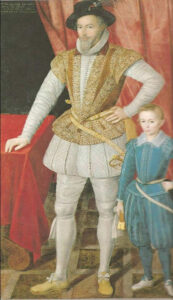
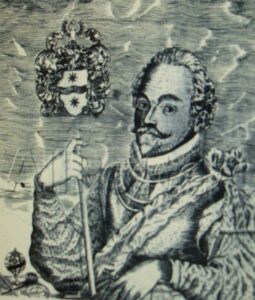
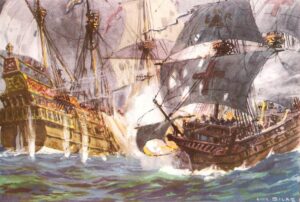



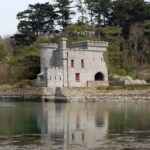

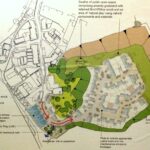
This is a very interesting article, I believe that all these Devon Elizabethan sailors and not just the obvious cousins are related and If you are linked to one you are probably connected to them all in fact I can show how in my new book TURNER TREES, I have spent much time researching this subject which is part of a greater revelation.
I found this article because in the British Museum there is a large and beautiful collection of silver dishes called the “Armada Plate”. It is said that it belonged to Sir Christopher Harris and was hidden until the 17C. It also states that Sir Christopher was Raleigh’s deputy and “responsible for the redistribution of goods from the Anglo Spanish war 1585-1609.”
I have found old papers of my grandmothers laying out in exacting detail our ancestral lineage right the way back to the Harrises of Radford and Haine/Hayne. She had even penned in her own hand dated 1955 all that she could remember of the verbal handed down tradition of the family and it certainly fits in almost exactly with everything you have written and researched – well done.
Excellent article, good pics, thanx.